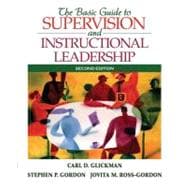
| Introduction | |
| SuperVision for Successful Schools | |
| SuperVision: A New Name for a New Paradigm | |
| Supervisory Glue as a Metaphor for Success | |
| Who Is Responsible for SuperVision? Organization of This Book | |
| The Agony of Thought and Feeling | |
| Knowledge | |
| The Norm: Why Schools Are as They Are | |
| The Work Environment or Culture of Schools | |
| The Legacy of the One-Room Schoolhouse | |
| Blaming the Victim and Structural Strain | |
| The Exception: What Schools Can Be | |
| Background to School Effectiveness Studies | |
| Early Effective Schools Research | |
| The Second Wave of Effective Schools Research | |
| Context Studies in Effective Schools Research | |
| Has Effective Schools Research Outlived Its Usefulness? | |
| The Legacy of Effective Schools Research | |
| From Effective Schools to School Improvement | |
| A Cause Beyond Oneself | |
| Summary | |
| Adult and Teacher Development within the Context of the School: Clues for Supervisory Practice | |
| Adults as Learners | |
| Adult and Teacher Development | |
| Developmental Theories of Motivation and Teacher Development | |
| Development: Ebb and Flow | |
| Propositions | |
| Reflections on Schools, Teaching, and Supervision | |
| The Coast of Britain | |
| Effective and Good Schools: The Same? | |
| Changing Views: New Emphasis on Constructivist Teaching and Learning | |
| Instructional Improvement and Effective Teaching | |
| Beliefs about Education | |
| Supervision Beliefs | |
| Supervisory Platform as Related to Educational Philosophy | |
| Checking Your Own Educational Philosophy and Supervisory Beliefs | |
| What Does Your Belief Mean in Terms of Supervisor and Teacher Responsibility? | |
| Summary, Conclusions, and Propositions | |
| Interpersonal Skills | |
| Supervisory Behavior Continuum: Know Thyself | |
| Outcomes of Conference | |
| Valid Assessment of Self | |
| Johari Window | |
| Cognitive Dissonance | |
| Summary, Conclusions, and Preview | |
| Developmental Supervision: An Introduction | |
| Case Study One | |
| Case Study Two | |
| Case Study Three | |
| Case Study Four | |
| Developmental Supervision | |
| Summary and a Look Ahead | |
| Directive Control Behaviors | |
| Directive Control Behaviors with Individuals | |
| Directive Control Behaviors with Groups | |
| A History of Overreliance on Control | |
| Issues in Directive Control | |
| When to Use Directive Control Behaviors | |
| Moving from Directive Control toward Directive Informational Behaviors | |
| Directive Informational Behaviors | |
| Directive Informational Behaviors with Individuals | |
| Directive Informational Behaviors with Groups | |
| Comparing Directive Control and Directive Informational Statements | |
| Issues in the Directive Informational Approach | |
| When to Use Directive Informational Behaviors | |
| Moving from Directive Informational toward Collaborative Behaviors | |
| Collaborative Behaviors | |
| Collaborative Behaviors with Individuals | |
| Collaborative Behaviors with Groups | |
| Issues in Collaborative Supervision | |
| When to Use Collaborative Behaviors | |
| Moving from Collaborative toward Nondirective Behaviors | |
| Collaboration and Cooperation | |
| Nondirective Behaviors | |
| Nondirective Behaviors with Individuals | |
| Nondirective Behaviors with Groups | |
| Initiating Nondirective Supervision | |
| Nondir | |
| Table of Contents provided by Publisher. All Rights Reserved. |
The New copy of this book will include any supplemental materials advertised. Please check the title of the book to determine if it should include any access cards, study guides, lab manuals, CDs, etc.
The Used, Rental and eBook copies of this book are not guaranteed to include any supplemental materials. Typically, only the book itself is included. This is true even if the title states it includes any access cards, study guides, lab manuals, CDs, etc.